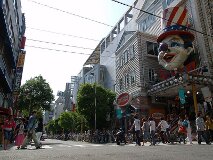
In Kansai-ben, there is more accent than there are in standard Japanese--accent is very important in Kansai-ben. While listening to the Kansai accent can be useful in understanding and producing it, it is important to understand the underlying characteristics that compose it. All words can be placed into one of four groups defined by two characteristics.
The first characteristic is the pitch? of the first mora?. All words are classified into two groups: group H where the first mora's pitch is high and group L where it's low.
The second characteristic is called the downstep?. A downstep is where a high pitched mora's sound starts to fall. A downstep can occur anywhere or not at all, but if the mora starts with a low pitch it cannot (naturally) occur there. Also, it's rare for the downstep to occur in the final aremora of a longer word. In special mora--nasals (ん), long vowels (もう, etc.), and long consonants (the っ in 切った)--downsteps can occur in Kansai-ben, but don't appear in standard Japanese. See "downstep examples" for the examples.
After a downstep occurs in a word, no more high pitched mora will occur, the same as in standard Japanese. It's good to note that one can discriminate between compound words versus separate words using this (e.g., cheese cake, cheesecake).
To practice listening for these characteristics, please see the intonation differences between standard Japanese and Kansai-ben in common phrases and sentences.

